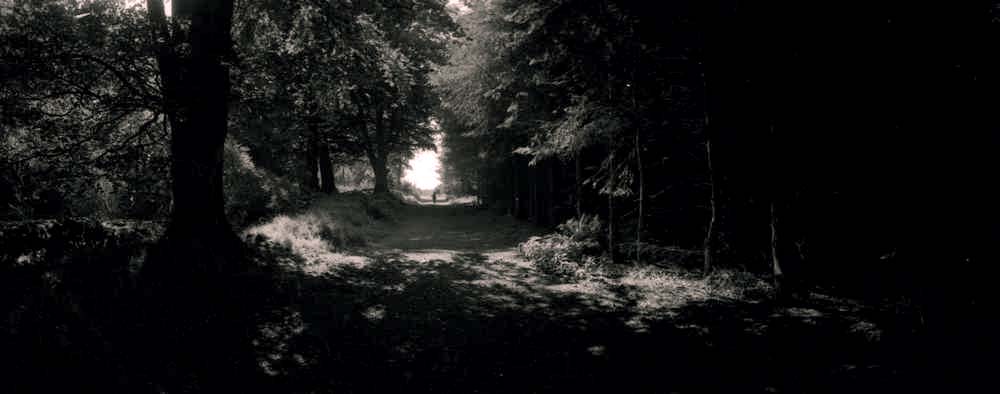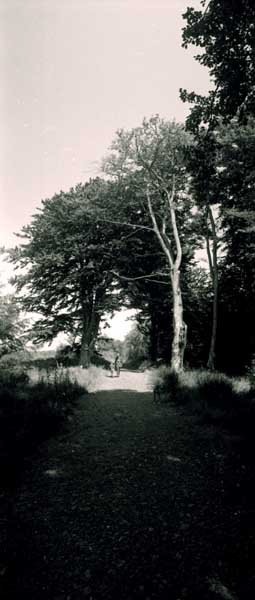 Watkins' Ley-lines--a desire to see pattern. Pic: Rod Fleming[/caption]
Watkins' Ley-lines--a desire to see pattern. Pic: Rod Fleming[/caption]Alfred Watkins' Ley-lines
Ley-lines were invented by an Englishman called Alfred Watkins, who had spent much time cycling around the countryside near his home. In 1925, he wrote a book called “The Old Straight Track”, in which he described a revelation he’d had while looking at a map of Herefordshire four years earlier. He had suddenly seen a network of straight lines that connected points of human activity, such as
“Mounds, Long-barrows, Cairns, Cursus, Dolmens, Standing stones, mark-stones, Stone circles, Henges, Water-markers (moats, ponds, springs, fords, wells), Castle, Beacon-hills, Churches, Cross-roads, Notches in hills,”
He theorised that in fact these showed the presence of a prehistoric network of paths, which had subsequently fallen into disuse, so that all that was left on them were the way-points, in the form of the markers described above. He also suggested that any 'true' ley-line began and ended at a hill. Watkins himself stopped using the term 'ley-line' in 1929, preferring to use the terms 'old straight tracks' or 'archaic tracks.'
Perhaps he was already aware that others had found in his ideas something he did not mean to suggest; he could hardly have foreseen that his theory would spawn an entire sub-culture.
The rabbit, however, was off and running. In 1936, a popular novelist called Dion Fortune wrote a fictional book called 'The Goat-Foot God' which used the idea of lines of occult power running between megalithic sites such as at Stonehenge and Avebury, loosely based on Watkins’ ley-lines.
World War Two intervened and perhaps people had enough to do during it and the period of reconstruction that came after; but in 1960 an ex-Royal Air Force pilot called Tony Webb took the lunacy up a gear when he wrote a pamphlet claiming that ley-lines were lines of force that alien space-ships used to navigate when they came to visit earth. Wedd was keen on popular fiction and a UFO-hunter. As a pilot, he would have been aware of systems like the Decca Navigation System, in which beacons transmitted radio signals that could be triangulated to provide a position for an aircraft's navigator.
Ley-lines, The Foundation of New Age belief
[caption id="attachment_550" align="alignright" width="255"]
 Pic: Rod Fleming[/caption]
Pic: Rod Fleming[/caption]The seminal work, however, was a book called 'The View Over Atlantis' by John Michell, which played well into the Zeitgeist of the era. In it, Michell combined Watkins' ley-lines, which had no supernatural or astrological element whatsoever, with the Chinese concept of feng shui, in which a structure or site is chosen or configured to align with the spiritual forces that are said to inhabit it.
This combination of a plausible but false theory of archaeology with Chinese mysticism proved very popular, and 'The View Over Atlantis' was described by the historian Ronald Hutton as "almost the founding document of the modern earth mysteries movement." However, Hutton also describes the book as being "quite unacceptable to orthodox scholarship."
Despite the obvious flaws in Michell's methodology, his book had a huge effect, and the cosmic significance of ley-lines became established within New Age culture. It was quickly linked with the Nazca lines in South America, which had also been ascribed to alien intervention. Ley-lines were described as mystical lines of energy that formed a sort of psychic grid throughout the world, which those attuned, could tap into and use; this was why so many churches were on ley-lines. They have been linked the Aboriginal Song Lines of Australia, and even represented as lines of cosmic force that descend from celestial bodies into the earth, and then travel along the ground. Indeed, an entire culture of so-called New Age thinking grew up based on this.
Naturally the academics and scientists who studied the idea, like Hutton, threw it out, since there is no evidence at all to support it. Watkins' initial revelation referred to Herefordshire in England, an area which is particularly dense in exactly the type of markers that he suggested were relevant. In fact it is so dense that if you take a map of reasonable scale and a ruler, and place the ruler between any two of these markers twenty miles or so apart, you will certainly find several of these markers either on the line or sufficiently near it to be within a reasonable margin of error.
However, this can be achieved using only the natural markers; so that pure chance could have established this network of 'lines.' In fact, the number of alignments that can be found doing this is no more than would be the case if chance were the agent. This has been theoretically confirmed in several ways; a geometric analysis of 137 random dots on a plane will reveal 80 4-point alignments, and archaeologist Richard Atkinson mapped the positions of modern telephone boxes, to reveal similar alignments, which he called 'telephone leys'. His point of course, was that we know that the boxes were not set up on straight lines, so the fact that alignments do occur must be sheer chance. Thus there is no reason whatsoever to suppose any agency other than chance in the alignments between Watkins' 'markers'.
Nevertheless, while the use of Occam's razor might be tempting here, there remains the possibility that, as Watkins proposed, the lines were simply straight lines of sight between landmarks. Not unnaturally, if people were travelling along them, this would promote settlement; that is to say that even though the alignments could have happened by chance anyway, some of the man-made ones, at least, were deliberate.
But this too is a false proposition. Aeroplanes and ships may navigate along straight lines, but people on the ground do not, and that is because there are things in the way. Even in a wilderness as empty as the Scottish Highlands, it is simply impossible to walk a straight line for any distance. In southern England, which was at the time heavily forested, and remains full of rivers, hills and other natural obstacles, the problem becomes quite insurmountable. People do not travel along straight paths, they travel along the most practical ones. These may involve deviating from the line-of-sight route for miles to avoid marshes, dense forest, or rivers too deep to ford, to give but three examples.
Settlements do not grow up on straight lines either, but where there is advantage, such as on fording or bridging points on rivers, at the opening of passes between mountains, where there are natural resources to exploit or where the land is good for agriculture, where there is good water, in strong defensive positions, and so on, and people travel between these, not the other way round.
The paths that we choose will be conditioned by geography, and also by things like the availability of shelter from bad weather, not to mention the avoidance of areas where we might be set upon; as much a concern for the Palaeolithic man transporting a sack of goods for sale as for someone attempting to navigate central Glasgow on a Saturday night.
All that can really be said is that some prominent natural markers were almost certainly used by our ancestors as landmarks to help them navigate the countryside. They probably used man-made waypoints as well, such as those that Watkins proposed.
This is, after all, exactly how we navigate today. Ask anyone for directions and they will give a series of waypoints and instructions, such as these, leading from my house to the old village station: 'Go out the front door, cross the road towards the church, cross the yard, turn right at the little lane on the other side, turn left at the end of that, walk down the hill and the old station is in front of you.' Note the use of waypoints: front door, road, church, lane, hill; and of instructions: out, cross, turn, walk down.
What we would not do, however, would be to try to travel from here to the station in a straight line, for that would mean scaling a wall, flying over the Town House, climbing another, two-metre high stone wall, walking through a vegetable garden and a yard containing two large and not very friendly dogs, crossing a fence, and wading through a cattle-trough. Clearly to do so would be preposterous, and such a thing always was; we do not travel on straight paths, but by the most practical ones.
This proves, if further proof were needed, that Watkins' original theory, without which there would have been no book, and no spark to set off the subsequent brushfire, is false. All that happened was that he succumbed to the well-known human habit of seeing pattern and agency in everything.
Since the foundation is invalid, all the later theories are false too; but such is their attraction to belief that many people refuse to accept this, instead insisting either that the original theory is sound, in the face of all evidence to the contrary, or that even if Watkins were wrong, the lines of force that were later proposed, or whatever the viewer 'believes' is there, nevertheless exist.
What concerns us here is the way in which a set of beliefs have grown up, initially surrounding a proposition which we know the origin of and can easily demonstrate is completely without foundation, that proceed on to encompass beliefs which had nothing to do with the original, instead being later additions, but which use the original to support themselves. Consider Wedd's proposition that 'ley-lines' were lines of energy used for navigation by alien spacecraft, or Michell's weird juxtaposition of unfounded pseudo-science with Oriental mysticism.
So, from an observable phenomenon, that there are lines of sight between landmarks, and a reasonable proposition, that people use landmarks to navigate, has developed a hypothesis which seems at first sight plausible but which is false, that straight roads existed between landmarks, which has further spawned a belief, based in no fact at all, that aliens navigate the earth along these lines. This then develops, now accelerating away from any contact with reality, to suggest that in fact these are lines of power in the earth, that they represent a cosmic connection with celestial bodies, and even a form of vitality within the earth, or more.
Incredible though it may seem, many people believe all this to be true; indeed within sections of the so-called 'New Age' community, it is taken as proven matter of fact that ley-lines are indeed lines of cosmic power, and this is in turn taken as proof of celestial connections, earth-deities and planetary consciousness. And this despite the fact that at every turn, recognised experts in the field of history, archaeology, and statistics, used to having their work peer-reviewed, have subjected the original proposition and its successors to scrutiny and have debunked them time and time again.
This shows us that belief, once established, is not only very hard indeed to repudiate, but is self-propagating; that is to say, if you like, that belief begets belief.
Join the Forum discussion on this post
Absolutely loved the photo - so atmospheric!
ReplyDeleteThanks Tove, it was taken just outside Arbroath in Scotland.
ReplyDelete